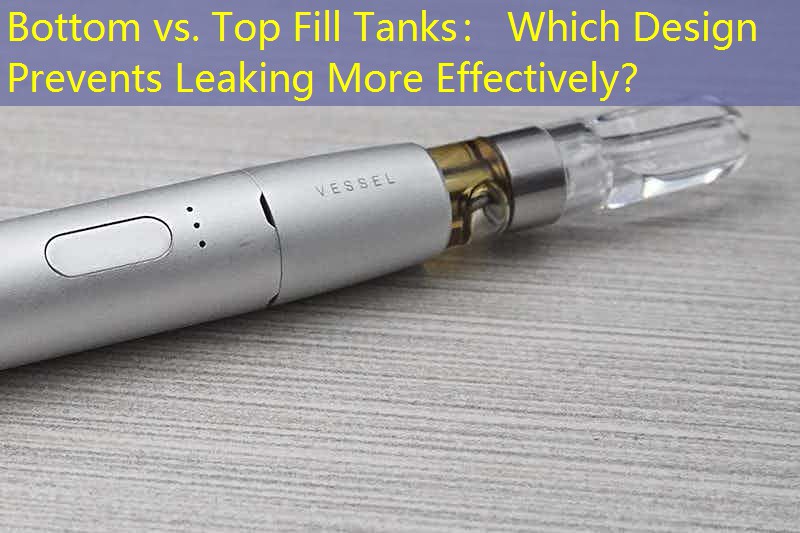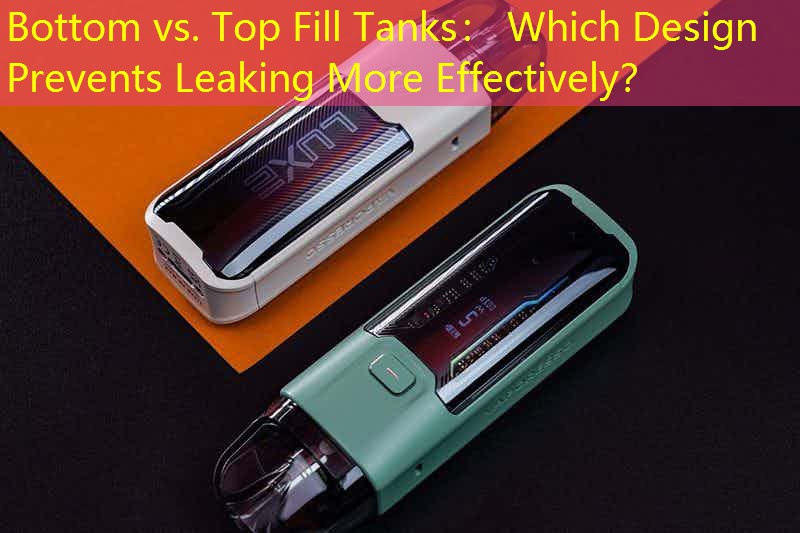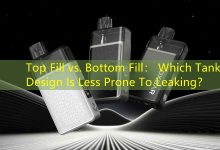Introduction à Bottom vs. Réservoirs de remplissage par le haut
Dans le monde du vapotage en évolution rapide, la conception des réservoirs d'e-liquide joue un rôle central dans l'expérience utilisateur globale. Parmi les différents modèles disponibles, les réservoirs à remplissage par le bas et par le haut restent deux des choix les plus populaires parmi les vapoteurs. La discussion sur la conception qui empêche le plus efficacement les fuites est cruciale pour les utilisateurs novices et expérimentés.. Cet article se plongera dans les spécifications, avantages, désavantage, et cibler les données démographiques des utilisateurs des réservoirs de remplissage par le bas et par le haut.
Présentation des produits et spécifications
Les réservoirs de remplissage inférieurs sont conçus avec le réservoir d'e-liquide situé à la base de l'appareil. La conception intègre généralement un mécanisme de mèche plus complexe qui aspire le liquide jusqu'à la bobine.. Une spécification courante pour les réservoirs à remplissage par le bas inclut une capacité de 2 à 5 millilitres, qui est une gamme standard sur le marché.
Inversement, les réservoirs à remplissage supérieur ont un réservoir situé en haut, offrant un accès rapide pour remplir le réservoir. La conception présente généralement une méthode de recharge plus simple, utilisant souvent un mécanisme coulissant ou un système de bouton-poussoir. La capacité des réservoirs à remplissage par le haut peut également varier de 2 à 6 millilitres, les rendant tout aussi compétitifs en termes de volume.
Avantages des réservoirs à remplissage par le bas
L'un des principaux avantages des réservoirs à remplissage par le bas est leur capacité à fournir un profil de saveur plus doux.. Le système de mèche garantit souvent que le e-liquide s'écoule de manière constante vers la bobine, ce qui entraîne moins de goût brûlé et une meilleure diffusion de la saveur. En plus, de nombreux utilisateurs signalent que les réservoirs à remplissage inférieur sont moins sujets aux coups secs, permettant une expérience de vapotage plus agréable.
Un autre avantage est que grâce à leur conception, les réservoirs de remplissage par le bas ont tendance à avoir une étanchéité plus forte lorsqu'ils sont fermés correctement. Cela peut réduire les risques de fuite, surtout lors d'une utilisation prolongée ou lorsque le réservoir subit des changements de pression.
Inconvénients des réservoirs à remplissage par le bas
Malgré leurs avantages, les réservoirs à remplissage par le bas présentent certains inconvénients. La complexité de la conception peut conduire à un processus de remplissage plus exigeant en main-d'œuvre, en particulier pour ceux qui débutent dans le vapotage. Les utilisateurs peuvent également avoir du mal à nettoyer soigneusement le réservoir en raison de ses composants complexes..
En outre, car le liquide doit être aspiré jusqu'au serpentin, il peut y avoir un risque d'inondation si le réservoir est trop rempli ou si la batterie n'est pas correctement amorcée. Ce problème peut entraîner des fuites, ce qui constitue une préoccupation importante pour de nombreux utilisateurs.
Avantages des réservoirs à remplissage par le haut
Les réservoirs à remplissage par le haut offrent une commodité inégalée en matière de remplissage. La conception conviviale permet aux vapoteurs de reconstituer leur e-liquide rapidement sans avoir à démonter l'appareil.. Cette facilité d'utilisation rend les réservoirs à remplissage par le haut particulièrement attrayants pour les vapoteurs débutants qui ne sont peut-être pas familiers avec des configurations plus complexes..
En plus, les réservoirs à remplissage supérieur ont moins de risques d'inondation puisque le e-liquide n'a pas besoin de voyager vers le haut pour atteindre la bobine. Cela peut se traduire par un risque moindre de fuite pendant le processus de remplissage..

Inconvénients des réservoirs à remplissage par le haut
Du côté négatif, les réservoirs à remplissage supérieur peuvent être plus susceptibles de fuir s’ils ne sont pas correctement scellés. Le mécanisme utilisé pour fermer le réservoir peut ne pas toujours fournir une étanchéité robuste, surtout avec le temps, à mesure que l'usure se produit. Ce potentiel de fuite peut dissuader certains utilisateurs qui privilégient une expérience sans gâchis..
De plus, l'exposition de la mèche à l'air lors du remplissage peut introduire des bulles d'air, conduisant à des gargouillis ou à des crachats. Pour les utilisateurs qui préfèrent une expérience de vapotage silencieuse, cela pourrait être un inconvénient notable.
Données démographiques des utilisateurs cibles

La population cible des utilisateurs des réservoirs à remplissage par le bas a tendance à se tourner vers les vapoteurs expérimentés qui apprécient les profils de saveurs nuancés et sont à l'aise dans la gestion d'une configuration plus complexe.. Ces utilisateurs ont souvent envie d’explorer les aspects techniques du vapotage et sont prêts à investir du temps dans la maîtrise de leurs appareils..
D'autre part, les réservoirs à remplissage supérieur s'adressent à un public plus large, y compris les vapoteurs débutants et ceux qui recherchent la commodité. Leur conception intuitive séduit les utilisateurs qui privilégient la facilité d'utilisation plutôt que les mécanismes complexes.. Ce groupe démographique comprend particulièrement les personnes qui sont susceptibles de passer du tabagisme traditionnel au vapotage et qui recherchent des solutions simples..
Conclusion
En résumé, les réservoirs de remplissage par le bas et par le haut répondent à des objectifs distincts et attirent différents segments de la communauté du vapotage. Alors que les réservoirs à remplissage inférieur peuvent offrir une meilleure saveur et moins de risques de coups secs, ils présentent le défi d'un processus de remplissage plus complexe. Inversement, les réservoirs à remplissage par le haut offrent commodité et facilité, mais peuvent rencontrer des problèmes de fuite s'ils ne sont pas manipulés correctement. Finalement, la décision dépend des préférences individuelles, niveau d'expérience, et l'importance de la prévention des fuites dans l'expérience globale de vapotage.







